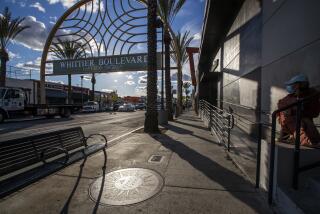Only 2 of 6 Mayoral Candidates Attend L.A. Secession Debate
- Share via
The feeling of neglect among Los Angeles residents who wish to break away from the city was reinforced Sunday when only two of the six major mayoral candidates appeared at a secession debate in Hollywood.
Representatives of secession movements from Hollywood, the San Fernando Valley, San Pedro and Wilmington nevertheless received some encouragement if not backing from candidates Steve Soboroff and Antonio Villaraigosa.
Both mayoral aspirants oppose secession, but said the frustration residents in those communities feel with city government is justified.
“I will work hard to eliminate the causes why people want to secede,” said Soboroff, a real estate developer who has served on city commissions and works as an unpaid advisor to Mayor Richard Riordan.
Villaraigosa, an assemblyman who recently served as speaker, said, “The city is adrift and off-course, but I’m not ready to give up on it.”
While called a debate, the gathering at the New Ivar Theatre in Hollywood was more of a group discussion on secession, with the candidates commenting on remarks made by secession leaders from the three areas. About 70 people attended the morning event.
Leaders of the secession movements back each other’s efforts, which if successful would result in Los Angeles splitting into four cities.
Each area has its own complaints about Los Angeles, but the three representatives all said it is too big --both in population and geography--to function as a single city.
Fares Wehbe, representing the Hollywood independence effort, said his area is too large to be served by a single mayor and the 15-member Los Angeles City Council. Wehbe said Hollywood alone could use five or more council members.
“God Almighty himself could not govern this town,” Wehbe said, drawing laughter from Soboroff and Villaraigosa.
Wehbe said newly created neighborhood councils are not enough to give residents more influence in city decisions. “Neighborhood councils are important, but they are advisory. We need councils that are elected, not appointed by the city government, and with a budget they control,” he said.
Richard Close, head of the San Fernando Valley secession group Valley VOTE, expressed his frustration with City Hall indirectly. Instead of presenting the audience with secession arguments, he asked, “How many in this room think the city should have spent $4 million for the Democratic Convention?” No hands went up.
Andrew Mardesich, speaking for Harbor area secessionists, said his community’s small size and distance from downtown means residents often are overlooked. He criticized big-ticket city projects that do little for the Harbor area. The Alameda Corridor transportation project, for instance, has resulted in only nine San Pedro and seven Wilmington residents getting jobs on the project, he said.
The two candidates spent more than two hours listening to the secession backers and agreeing with their complaints, while ultimately arguing for Los Angeles to continue as one city.
Soboroff said Los Angeles has more clout in Washington and Sacramento than it would as four smaller cities. He likened the secession movements to “people talking about a divorce, talking about things like whether it’ll be bad for the kids, we’ll have to split the house, when they could be spending the time discussing how to make it work.”
Villaraigosa said a breakup would cost the city “50% of its middle class, we’d lose the harbor, our economic engine; we’d lose Hollywood, our cultural heart; and maybe West Los Angeles shortly after. We’d lose the heart of L.A. and leave the rest of the city without resources it needs to confront problems.”
If the secession movements continue, voters could decide the issue in November 2002.
Close said that in the San Fernando Valley, people are already voting with their feet. “Valley secession is occurring today, with people moving to Santa Clarita, Valencia, Burbank . . . places where they can be closer to their elected officials.”
More to Read
Sign up for Essential California
The most important California stories and recommendations in your inbox every morning.
You may occasionally receive promotional content from the Los Angeles Times.












